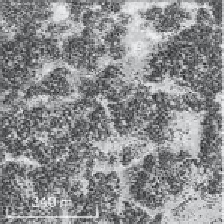Environmental Engineering Reference
In-Depth Information
(a)
(b)
Figure 6.2. (a) Example of aerial photograph showing vegetation pattern in New
Mexico (34
◦
46
57.60
N, 108
◦
20
35.56
O) and (b) numerical simulation of model
(
6.7
)at
t
=
100,
μ
=
0
.
1,
D
=
80,
s
gn
=
2. Google Earth imagery c
Google Inc.
Used with permission.
ξ
gn
=
ξ
gn
+
μ
where
is a white Gaussian noise with mean equal to
μ
and intensity
s
gn
. In this case the pdf of
v
is the same as before but with the mean shifted by
μ
)as
the result of a local linear decay, vegetation's spatial interactions (the diffusive term
D
. Equation (
6.7
) expresses the temporal evolution of the existing vegetation (
v
2
∇
v
), and a random growth term (the noise term
ξ
+
μ
), which is on average
gn
the same at all points in space (
gn
) in space and
time because of local variability in soil properties or microclimate conditions. The
distribution of vegetated sites in semiarid environments exhibits spatial configura-
tions resembling those shown in Fig.
6.1
. If we assume a constant noise intensity
s
gn
, we can obtain the coefficient of variation CV
v
of the field - defined as the
ratio between the standard de
viat
ion a
nd the m
ean - by using the mean-field anal-
ysis. It is found that CV
v
=
√
s
gn
/
μ
), though it exhibits fluctuations (
ξ
μ
√
2
(
+
2
D
) decreases with increasing values of
μ
) would exhibit stronger fluctuations
(i.e., more variability) in vegetation cover than a subhumid system (high
. This means that an arid ecosystem (low
μ
), consis-
tent with the stronger contrast between vegetated and nonvegetated zones typically
observed in arid areas. In Fig.
6.2
we compare a real vegetation pattern with a nu-
merical simulation of Eq. (
6.7
). These patterns exhibit irregular boundaries, and no
clear periodicity can be detected because many wavelengths are involved (multiscale
patterns).
Models of noise-induced pattern formation and nonequilibrium phase transitions
typically invoke the presence of multiplicative noise (
van den Broeck et al.
,
1994
;
Garcia-Ojalvo et al.
,
1996
;
Grinstein et al.
,
1996
;
Muller et al.
,
1997
;
Sieber et al.
,
2007
) along with a high-order diffusion term (e.g., the Swift-Hohenberg coupling
term; see Section
6.2
). The influence of additive noise on the transition to ordered
states has mainly been investigated in systems affected by the concurrent action
of a multiplicative noise (
Landa et al.
,
1998
;
Zaikin et al.
,
1999
) with only a few
μ



Search WWH ::

Custom Search